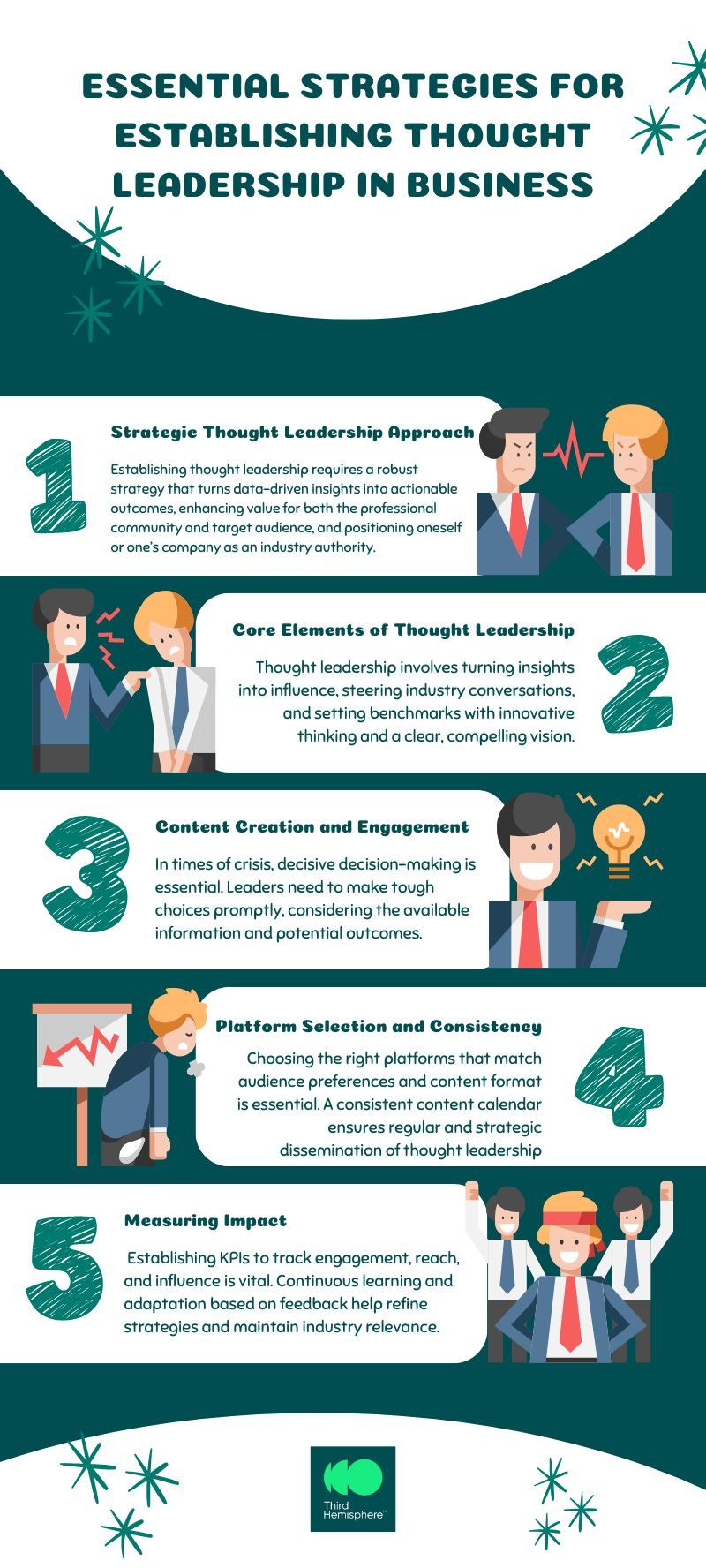In the rapidly advancing business world, establishing oneself as an industry authority and gaining a competitive edge necessitates more than just innovative thinking; it demands a robust thought leadership strategy. This approach not only bridges the gap between data-driven insights and actionable outcomes but also significantly enhances value addition to both the professional community and the target audience. At its core, thought leadership is about transforming insights into influence, steering conversations, and setting benchmarks within any given industry. It’s about leveraging content performance to foster a sense of trust and credibility, ultimately positioning oneself or one’s company at the forefront of innovation and expertise.
Embarking on the journey to craft and implement an effective thought leadership strategy involves several key steps, including defining your unique area of expertise, creating engaging and authentic content, and choosing the right platforms for content distribution. Strategies such as LinkedIn thought leadership strategy have shown immense potential in connecting with a professional community, emphasizing the importance of selecting suitable channels. Building a consistent content calendar, engaging with your community, and measuring the impact of your efforts are crucial components that work synergistically to amplify your message. This article offers a comprehensive guide on how to build a thought leadership strategy that resonates with your audience, fortifies your industry authority, and drives long-term thought leadership strategy benefits.

Understanding Thought Leadership
Thought leadership transcends beyond merely possessing insightful ideas; it involves the ability to transform these ideas into actionable strategies that yield tangible results across a business. This transformation is crucial for developing a dedicated follower base that can replicate and scale these ideas, thereby delivering measurable outcomes for the business.
The Essence of Thought Leadership
At the heart of thought leadership lies the capacity for original thinking. Thought leaders stand out not as followers of conventional wisdom but as innovators who constantly challenge the status quo with questions like “What if?” and “How can I improve this?” Their ability to let go of ideas that do not withstand scrutiny further underscores their commitment to quality and innovation.
Vision and Communication
A defining trait of thought leaders is their clear and compelling vision for the future. They possess the unique ability to not only foresee developments years in advance but also articulate this vision in a manner that resonates with their audience. Execution of these visions by the right team members is key to driving impactful results.
Courage to Be Controversial
While not inherently seeking controversy, thought leaders often find themselves at the center of debates due to the forward-thinking nature of their ideas. This willingness to embrace controversy, however, is seen as a testament to their commitment to innovation and progress.
Passion and Articulation
The passion thought leaders have for their ideas is palpable. They are adept at making compelling arguments in support of their vision while also being open to counterarguments. This balance of passion and openness is crucial for engaging effectively with both supporters and detractors.
Listening and Learning
Good listeners by nature, thought leaders value the insights gained from both supporters and critics. This openness to learning and adapting their views based on constructive feedback is a hallmark of effective thought leadership.
Commanding Attention
The ability to engage with diverse audiences is another key attribute of thought leaders. They excel at breaking down complex ideas into understandable concepts, making their insights accessible to a wide range of listeners.
Economy of Words
In their communication, thought leaders are known for their succinctness. Every word is chosen carefully to convey meaning effectively, avoiding unnecessary verbosity.
Fostering a Follower Base
The cultivation of a dedicated follower base is a continuous process for thought leaders. They not only know the right people but also ensure that these key individuals are aware of them and their ideas.
Supportive Marketing Communications
Behind every successful thought leader is an excellent marketing communications team. This team plays a critical role in amplifying the thought leader’s natural abilities, helping them refine their message and gain the visibility needed for keynote addresses, interviews, and more.
In summary, thought leadership is a multifaceted endeavor that requires a blend of passion, vision, and the ability to engage and inspire others. By adhering to these principles, thought leaders can significantly impact their industries, driving innovation and fostering a culture of continuous learning and improvement.
Defining Your Expertise
Identifying Your Niche
To establish oneself as a thought leader, identifying a specific niche is crucial. This involves pinpointing areas where one’s passion and expertise intersect with market needs. Individuals should focus on areas they are passionate about and capable of solving specific problems or addressing gaps in existing knowledge. It’s essential to ensure that the chosen niche aligns with one’s career aspirations and offers unique perspectives or solutions that are not widely available.
Expertise and Thought Leadership
A thought leader’s strength lies in their deep expertise in specific domains, whether it’s a particular industry, a professional function like sales or policy, or even leadership itself. Such expertise is critical as it grounds the thought leader’s ideas and insights, making them both relevant and impactful. This foundational expertise is what allows thought leaders to contribute meaningfully, whether through media engagements or authored articles.
Developing Unique Perspectives
Once a niche is identified, the next step is crafting a unique perspective within that niche. This involves a deep dive into one’s experiences and insights to offer viewpoints that are not only fresh but also resonate with the target audience. Reflecting on personal expertise and experiences helps in understanding what one knows that others might not, and how these unique insights can contribute to the broader discourse.
Innovation and Content Creation
Becoming a thought leader also entails a commitment to innovation and the creation of new methodologies or products. This might include developing proprietary models, tools, or platforms that not only enhance one’s credibility but also provide tangible tools others can use. For instance, creating a new coaching platform or licensing proprietary methods to other professionals can significantly bolster one’s status as a thought leader.
Continuous Learning and Adaptation
The journey of a thought leader is one of continuous learning and adaptation. It’s about being open to shifting one’s focus if the initial niche does not resonate as expected. Engaging actively with the community and being receptive to feedback are pivotal in refining one’s niche and approach. This adaptability ensures that the thought leader remains relevant and continues to add value to their audience.
By focusing on these areas, individuals can define their expertise effectively and position themselves as thought leaders who not only possess valuable insights but also have the capability to influence and lead discussions in their respective fields.

Creating Engaging and Authentic Content
Know Your Audience
The foundation of creating engaging content is understanding who the audience is, their needs, and what they value. This involves identifying their pain points, goals, and preferences to craft content that is both relevant and useful. It is essential to speak directly to the needs, challenges, and aspirations of the audience, focusing on solving their problems rather than promoting oneself.
Utilise Tools for Audience Insights
Leveraging tools like SparkToro can provide insights into online user behavior around specific keywords, helping to tailor content that addresses the audience’s questions and pain points. Answerthepublic.com is another resource for discovering the queries users are making about industry topics, which can guide content creation to be more focused and relevant.
Storytelling and Value Addition
Incorporating storytelling into thought leadership content can significantly enhance connection and memorability. Each piece of content should aim to provide value, which could be in the form of solving a problem, offering a new perspective, or sharing a best practice. Authenticity in tone, style, and message ensures that the content resonates more deeply with the audience.
Engage and Respond
Engagement doesn’t end with publishing content. Responding quickly and thoughtfully to audience interactions can add a deeper layer of value, showing commitment and respect towards the audience’s input. This approach not only enhances engagement but also builds trust and credibility.
Share Expertise and Experiences
Sharing personal experiences and expertise can make thought leadership content more relatable and credible. This includes discussing challenges faced and how they were overcome, which enriches the content and provides a practical view of applying theoretical knowledge.
Maintain Authenticity and Quality
Authenticity is crucial; it involves being genuine about one’s expertise and passion for the subject matter. Content should be transparent, honest, and clear of ulterior motives such as undisclosed sponsorships. High-quality content that avoids being overly promotional or irrelevant is key to sustaining audience interest and trust.
Practical Advice and Actionable Strategies
Providing practical advice and actionable strategies can demonstrate expertise and help the audience achieve tangible results, further cementing the thought leader’s credibility and influence. Sharing insights on current issues and developing educational resources like webinars or tutorials can also significantly enhance engagement and learning opportunities for the audience.
By focusing on these strategies, thought leaders can create content that not only engages and informs but also builds lasting relationships and trust with their audience.
Choosing the Right Platforms to Publish
Identifying the Ideal Platform
When selecting the appropriate platform for thought leadership content, it is crucial to identify where the target audience spends most of their time, be it on social media, blogs, forums, or podcasts. Understanding the strengths and weaknesses of each platform is essential, as is choosing one that complements the creator’s skills and expertise. Additionally, the type of content planned—its nature and format—should influence the platform choice, ensuring it supports the content effectively.
Strategic Considerations
Before deciding on a platform, one must have a clear understanding of their goals with their thought leadership. Whether the aim is to build a personal brand, generate leads, influence decision-makers, or educate an audience, these goals will dictate the prioritization of different metrics like reach, engagement, conversions, or credibility. Knowing the audience’s demographics, preferences, pain points, and behaviors is equally vital, as this information guides the tailoring of content to meet audience needs.
Content Formats and Their Platforms
Different platforms cater to various content formats and lengths. For instance, thought leadership that requires detailed explanation and extensive research may find its home in whitepapers or eBooks. These formats allow for the inclusion of infographics and other visual elements, making the content as visually appealing as it is informative. On the other hand, video content is increasingly popular and can be a great medium for delivering insights through interviews, explainers, or live content.
Leveraging Existing Platforms
For those with established followings, platforms like blogs provide an immediate channel to disseminate thought leadership content, reacting quickly to industry changes or news. Guest blogging on established sites can also increase exposure, helping thought leaders showcase their expertise and expand their following. Social media, with its direct line to the audience, offers a dynamic environment for growing thought leadership through regular updates and engagement.
Consistency Across Platforms
Maintaining a consistent voice and message across chosen platforms is crucial. This consistency helps in building a coherent brand image that resonates with the audience. Regular and realistic content scheduling keeps the audience engaged and ensures that the thought leader remains a relevant and authoritative figure in their field.
By carefully analyzing these aspects and choosing the right platforms, thought leaders can effectively amplify their influence and reach their strategic goals.
Building a Consistent Content Calendar
What is a Content Calendar and Why is it Important?
A content calendar is fundamentally an editorial calendar tailored for thought leaders, encompassing strategies for blogs, newsletters, and social media postings. It serves as an organized system to plan what to post, and when and where it will appear on your platforms. Utilizing a content calendar allows for advanced planning and efficient use of time and energy in content creation and distribution. It also facilitates the extrapolation of a single piece of content into multiple updates across different platforms, enhancing the reach and impact of your thought leadership.
Getting Started with Your Content Calendar
Creating a content calendar can be as straightforward as using a simple spreadsheet or a printed calendar. The initial step involves deciding the frequency of posts and promotions across different platforms, considering the unique engagement patterns of each. For instance, Twitter may require more frequent updates compared to a blog. It’s also crucial to observe times when there is a spike in website visits or engagement, as these are optimal times for sharing new content.
Next, thought leaders should list their priorities, focusing on the types of messages to share or actions to drive, such as increasing website traffic or newsletter sign-ups. It’s a misconception that only original content can be posted on social media; content curation is a viable strategy that keeps the audience engaged and offers a variety of expert insights.
Popular Options for Creating and Maintaining a Content Calendar
For those starting without a budget, a piece of paper, pen, or a basic spreadsheet can suffice to map out a week’s worth of content. There are also free templates available, like HubSpot’s social media content template, which can provide structure and guidance. For a more comprehensive solution, services like HubSpot, Buffer, Sprout Social, Hootsuite, Asana, and Monday offer tools to help plan and post content effectively.
Strategic Content Planning
Identifying content categories and specific topics is crucial. Thought leaders should consider breaking down larger themes into smaller, detailed steps, which can aid in pinpointing specific blog post topics or social media content. It’s also beneficial to align content planning with industry events or major cultural conversations to ensure relevance and timeliness. Repurposing content that has previously performed well by adding a new twist relevant to current discussions can also be effective.
Continuous Review and Adaptation
Regularly updating and refining the content calendar is essential. This process involves reviewing upcoming schedules and industry calendars to plan around significant events and trends. Thought leaders should also look for daily inspirations that can be incorporated into their calendars, making the content creation process more dynamic and less daunting. If a book is available, it can serve as a foundation for planning an entire year of content, with each chapter potentially inspiring multiple pieces of content across various platforms.
By adhering to these strategies, thought leaders can build a consistent content calendar that not only manages their content effectively but also enhances their influence and authority in their respective fields.
Engaging with Your Community
Regular and Authentic Interaction
Building a community requires consistent and genuine engagement. This involves not only sharing content but also actively participating in discussions, responding to comments, and acknowledging feedback. Utilizing tools such as surveys, polls, and live events can help gather insights and stimulate interest, which fosters a deeper connection with the community. By showing up consistently and authentically, individuals can establish themselves as approachable and reliable leaders within their community.
Two-Way Communication
Engagement should be a two-way street. It is essential to not only disseminate information but also to listen and respond to the community. This approach builds trust and makes community members feel valued and heard. Hosting Q&A sessions and encouraging open forums for discussion are effective ways to facilitate this dynamic interaction.
Leveraging Feedback
Feedback from the community is invaluable in shaping content and strategies. Engaging with comments, direct messages, and posts from community members can provide insights into their preferences and needs, which can guide future content creation. Additionally, incorporating user-generated content can enhance the relevance and authenticity of the communication, further engaging the audience.
Personalization and Appreciation
Personalizing interactions and showing appreciation are crucial for fostering a loyal community. Recognizing contributions, celebrating community milestones, and personalizing responses can make members feel special and appreciated. This not only enhances engagement but also bolsters loyalty and support for the thought leadership brand.
By implementing these strategies, thought leaders can effectively engage with their community, creating a vibrant and interactive environment that benefits both the leader and the followers.
Measuring Your Impact
Establishing Key Performance Indicators (KPIs)
To effectively measure the impact of thought leadership efforts, it is crucial to establish specific Key Performance Indicators (KPIs) that align with strategic goals. These KPIs should be customized to reflect the objectives of the thought leadership strategy, such as enhancing brand visibility, securing speaking engagements, or fostering professional partnerships.
Utilizing Thought Leadership Scorecards
Developing a thought leadership scorecard facilitates a systematic approach to tracking and evaluating efforts. This scorecard should encompass a mix of quantitative and qualitative metrics, structured around the I-ACT framework which includes Influence Metrics, Audience Metrics, Content Metrics, and clearly defined Thought Leadership Goals.
Tracking Engagement and Interaction Metrics
Engagement metrics provide insights into how audiences interact with thought leadership content. Key indicators include likes, comments, feedback, and the overall social media engagement levels. These metrics help gauge content resonance and influence, and they are essential for understanding relationship-building progress with the audience.
Analyzing Reach and Awareness
Measuring the reach and awareness of thought leadership content involves tracking impressions, views, downloads, and shares. Comparing these metrics with industry benchmarks or competitors can offer valuable insights into the content’s distribution effectiveness and the thought leadership’s overall market standing.
Evaluating Influence and Reputation
To assess the influence and reputation in the industry, it is important to monitor citations, backlinks, endorsements, and media coverage. These metrics reflect the respect and credibility a thought leader commands in their field.
Surveys and Direct Feedback
Conducting surveys and gathering direct feedback from the target audience, peers, and industry experts are invaluable for measuring the effectiveness of thought leadership strategies. This feedback can highlight areas of success and aspects needing improvement, providing a direct line of communication with the engaged community.
Website Engagement Metrics
Website engagement metrics such as bounce rate, time spent on page, and interactions with downloadable content provide deeper insights into how effectively thought leadership content captures and retains audience attention. These metrics are crucial for evaluating the depth of engagement and the educational impact of the content.
By integrating these diverse metrics into a comprehensive evaluation framework, thought leaders can obtain a detailed understanding of their impact, allowing them to refine and enhance their strategies continuously.
The Long-Term Benefits of Thought Leadership
Strengthening Business Reputation and Market Position
Establishing thought leadership is a strategic long-term investment that significantly enhances a company’s reputation and strengthens its position in the market. By consistently providing valuable insights and forward-thinking ideas, businesses not only educate their customers but also position themselves as industry experts. This top-of-mind awareness is crucial for maintaining a steady flow of business and can be a critical differentiator in competitive industries.
Influence on Consumer Behavior and Talent Acquisition
Thought leadership has a profound impact on consumer behavior, influencing purchasing decisions and service adoption. Additionally, it plays a vital role in talent acquisition. Companies recognized as opinion leaders attract not only potential clients but also prospective employees, enhancing their performance and growth through strategic hiring.
Fostering Brand Loyalty and Customer Engagement
Effective thought leadership strategies lead to higher levels of customer engagement and loyalty. Providing audiences with immersive, multi-format content experiences across various channels ensures sustained interaction, which is essential for building trust and loyalty. Companies that engage their audience through dynamic storytelling and interactive content are more likely to retain their interest and support.
Amplifying Brand Reach and Impact
The evolution of thought leadership from single-format to multi-channel, immersive experiences allows companies to extend their reach and enhance their brand’s impact significantly. By integrating innovative content marketing techniques with traditional thought leadership, businesses can amplify their message and achieve greater visibility across diverse platforms.
Continuous Learning and Innovation
Thought leadership compels companies to stay on the cutting edge of industry trends and innovations. This commitment to continuous learning and adaptation not only fuels business growth but also ensures that the organization remains relevant and influential in a rapidly changing market.
Building a Cohesive Organizational Culture
A well-executed thought leadership strategy fosters a culture of openness and shared expertise within the organization. It encourages employees to contribute ideas and share knowledge, which enhances internal collaboration and drives collective success. This culture of innovation and openness is crucial for attracting top talent and fostering a motivated workforce.
By focusing on these long-term benefits, businesses can leverage thought leadership not just as a marketing tool but as a comprehensive strategy that permeates every aspect of organizational development and market interaction.
Conclusion
Through the comprehensive exploration of thought leadership strategies detailed in this article, we have underscored the critical components necessary for individuals and organizations aiming to establish industry authority. By focusing on identifying unique expertise, creating engaging content, selecting appropriate platforms for dissemination, and actively engaging with the community, thought leaders can significantly enhance their influence and credibility. This synergistic approach not only elevates the individual or organization’s position in the market but also fosters a culture of continuous learning and innovation, which is indispensable in today’s rapidly evolving business landscape.
The journey to thought leadership is marked by a commitment to quality, innovation, and authenticity. As demonstrated, thought leadership transcends mere content creation; it entails setting a vision, inspiring change, and driving discussions that shape the future of industries. In embracing these strategies, thought leaders not only contribute to their personal growth and organizational development but also play a pivotal role in advancing their respective fields. Thus, the path to becoming a thought leader, while demanding, offers profound rewards in terms of influence, reputation, and the ability to effect meaningful change.
FAQs
1. How can you create an effective thought leadership strategy?
To craft an effective thought leadership strategy, begin by defining who your target audience is. Next, research your competitors to understand the market landscape. Identify what makes your approach or product unique. Develop content that showcases your expertise and distribute this content through various channels, including social media, to reach a broader audience.
2. What does thought leadership entail?
Thought leadership involves sharing unique insights that establish your organization as a leading authority in your field. This strategic approach helps enhance your brand’s reputation and builds trust with key stakeholders, including decision-makers. It is typically integrated with marketing, communication, and business development strategies to secure a competitive edge.
3. What are effective ways to assess the impact of thought leadership initiatives?
To evaluate the effectiveness of your thought leadership efforts, consider these five key performance indicators (KPIs):
- Website Traffic: Monitor the increase in visitors to your website.
- Social Media Followers: Track the growth in your social media following.
- Branded Queries: Observe how often your brand is searched for online.
- Number of Backlinks: Count the links from other sites pointing to your content.
- Media Mentions: Note how frequently your brand is mentioned in the media.
4. What constitutes the framework of a thought leadership strategy?
The framework for a successful thought leadership strategy includes four main pillars:
- Credibility: Establish trust and authority in your field.
- Profile: Raise your visibility and brand awareness.
- Prolific Output: Consistently produce and share valuable content.
- Depth of Ideas: Offer profound insights that resonate with your audience.
These pillars are essential for climbing the ranks and becoming recognized as a thought leader.










